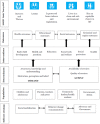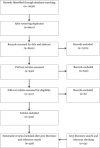Mega-map of systematic reviews and evidence and gap maps on the interventions to improve child well-being in low- and middle-income countries
- PMID: 37018457
- PMCID: PMC8356294
- DOI: 10.1002/cl2.1116
Mega-map of systematic reviews and evidence and gap maps on the interventions to improve child well-being in low- and middle-income countries
Abstract
Background: Despite a considerable reduction in child mortality, nearly six million children under the age of five die each year. Millions more are poorly nourished and in many parts of the world, the quality of education remains poor. Children are at risk from multiple violations of their rights, including child labour, early marriage, and sexual exploitation. Research plays a crucial role in helping to close the remaining gaps in child well-being, yet the global evidence base for interventions to meet these challenges is mostly weak, scattered and often unusable by policymakers and practitioners. This mega-map encourages the generation and use of rigorous evidence on effective ways to improve child well-being for policy and programming.
Objectives: The aim of this mega-map is to identify, map and provide an overview of the existing evidence synthesis on the interventions aimed at improving child well-being in low- and middle-income countries (LMICs).
Methods: Campbell evidence and gap maps (EGMs) are based on a review of existing mapping standards (Saran & White, 2018) which drew in particular of the approach developed by 3ie (Snilstveit, Vojtkova, Bhavsar, & Gaarder, 2013). As defined in the Campbell EGM guidance paper; "Mega-map is a map of evidence synthesis, that is, systematic reviews, and does not include primary studies" (Campbell Collaboration, 2020). The mega-map on child well-being includes studies with participants aged 0-18 years, conducted in LMICs, and published from year 2000 onwards. The search followed strict inclusion criteria for interventions and outcomes in the domains of health, education, social work and welfare, social protection, environmental health, water supply and sanitation (WASH) and governance. Critical appraisal of included systematic reviews was conducted using "A Measurement Tool to Assess Systematic Reviews"-AMSTAR-2 rating scale (Shea, et al., 2017).
Results: We identified 333 systematic reviews and 23 EGMs. The number of studies being published has increased year-on-year since 2000. However, the distribution of studies across World Bank regions, intervention and outcome categories are uneven. Most systematic reviews examine interventions pertaining to traditional areas of health and education. Systematic reviews in these traditional areas are also the most funded. There is limited evidence in social work and social protection. About 69% (231) of the reviews are assessed to be of low and medium quality. There are evidence gaps with respect to key vulnerable populations, including children with disabilities and those who belong to minority groups.
Conclusion: Although an increasing number of systematic reviews addressing child well-being topics are being published, some clear gaps in the evidence remain in terms of quality of reviews and some interventions and outcome areas. The clear gap is the small number of reviews focusing explicitly on either equity or programmes for disadvantaged groups and those who are discriminated against.
© 2020 The Authors. Campbell Systematic Reviews published by John Wiley & Sons Ltd on behalf of The Campbell Collaboration.
Figures



















Update of
-
PROTOCOL: Megamap of systematic reviews and evidence and gap maps on the effectiveness of interventions to improve child well-being in low- and middle-income countries.Campbell Syst Rev. 2019 Oct 10;15(4):e1057. doi: 10.1002/cl2.1057. eCollection 2019 Dec. Campbell Syst Rev. 2019. Update in: Campbell Syst Rev. 2020 Oct 28;16(4):e1116. doi: 10.1002/cl2.1116. PMID: 37016600 Free PMC article. Updated. No abstract available.
Similar articles
-
Interventions promoting uptake of water, sanitation and hygiene (WASH) technologies in low- and middle-income countries: An evidence and gap map of effectiveness studies.Campbell Syst Rev. 2021 Oct 8;17(4):e1194. doi: 10.1002/cl2.1194. eCollection 2021 Dec. Campbell Syst Rev. 2021. PMID: 36951806 Free PMC article.
-
Evidence and gap map of studies assessing the effectiveness of interventions for people with disabilities in low-and middle-income countries.Campbell Syst Rev. 2020 Jan 9;16(1):e1070. doi: 10.1002/cl2.1070. eCollection 2020 Mar. Campbell Syst Rev. 2020. PMID: 37131970 Free PMC article.
-
Effectiveness of road safety interventions: An evidence and gap map.Campbell Syst Rev. 2024 Jan 3;20(1):e1367. doi: 10.1002/cl2.1367. eCollection 2024 Mar. Campbell Syst Rev. 2024. PMID: 38188231 Free PMC article.
-
Impact of summer programmes on the outcomes of disadvantaged or 'at risk' young people: A systematic review.Campbell Syst Rev. 2024 Jun 13;20(2):e1406. doi: 10.1002/cl2.1406. eCollection 2024 Jun. Campbell Syst Rev. 2024. PMID: 38873396 Free PMC article. Review.
-
Impact of social protection on gender equality in low- and middle-income countries: A systematic review of reviews.Campbell Syst Rev. 2022 May 25;18(2):e1240. doi: 10.1002/cl2.1240. eCollection 2022 Jun. Campbell Syst Rev. 2022. PMID: 36913187 Free PMC article. Review.
Cited by
-
Interventions that address institutional child maltreatment: An evidence and gap map.Campbell Syst Rev. 2021 Mar 9;17(1):e1139. doi: 10.1002/cl2.1139. eCollection 2021 Mar. Campbell Syst Rev. 2021. PMID: 37133265 Free PMC article.
-
PROTOCOL: Evidence and gap map protocol: Institutional responses to child maltreatment.Campbell Syst Rev. 2019 Sep 13;15(3):e1039. doi: 10.1002/cl2.1039. eCollection 2019 Sep. Campbell Syst Rev. 2019. Update in: Campbell Syst Rev. 2021 Mar 09;17(1):e1139. doi: 10.1002/cl2.1139. PMID: 37131519 Free PMC article. Updated. No abstract available.
-
PROTOCOL: Child and adolescent mental health and psychosocial support interventions: An evidence and gap map of low- and middle-income countries.Campbell Syst Rev. 2022 Feb 16;18(1):e1221. doi: 10.1002/cl2.1221. eCollection 2022 Mar. Campbell Syst Rev. 2022. PMID: 36908659 Free PMC article.
-
What are the methodological characteristics of evidence and gap maps? A systematic review and evidence and gap map.Cochrane Evid Synth Methods. 2024 Aug 5;2(8):e12096. doi: 10.1002/cesm.12096. eCollection 2024 Aug. Cochrane Evid Synth Methods. 2024. PMID: 40475113 Free PMC article.
-
Child and adolescent mental health and psychosocial support interventions: An evidence and gap map of low- and middle-income countries.Campbell Syst Rev. 2023 Aug 23;19(3):e1349. doi: 10.1002/cl2.1349. eCollection 2023 Sep. Campbell Syst Rev. 2023. PMID: 37621301 Free PMC article.
References
REFERENCES TO INCLUDED STUDIES
-
- 3ie (2016). Primary and secondary education evidence gap map. International Initiative for Impact Evaluation (3IE). 3IE. Retrieved from http://gapmaps.3ieimpact.org/evidence-maps/primary-and-secondary-educati...
-
- Productive Safety Nets Gap Map: All populations . International Initiative for Impact Evaluation (3IE). 3ie. Retrieved from http://gapmaps.3ieimpact.org/evidence-maps/productive-safety-nets-gap-ma...
-
- Aboud, F. E. , Tredoux, C. , Tropp, L. R. , Brown, C. S. , & Niens, U. N. (2012). Interventions to reduce prejudice and enhance inclusion and respect for ethnic differences in early childhood: A systematic review. Annual Review of Psychology, 32(4), 307–336. 10.1016/j.dr.2012.05.001 - DOI
-
- Adelman, S. , Gilligan, D. , & Lehrer, K. (2008). How effective are food for education programmes? A critical assessment of the evidence from developing countries. International Food Policy Research Institute, 9, 13225. http://ebrary.ifpri.org/cdm/ref/collection/p15738coll2/id/13310
ADDITIONAL REFERENCES
-
- Albers, B. , Fiennes, C. , Shlonsky, A. , Bjørndal, L. , Hennessy, J. , Krapels, J. , & Mildon, R. (2019). Title registration for an evidence and gap map: Institutional responses to child maltreatment. Retrieved from https://campbellcollaboration.org/library/institutional-responses-to-chi... - PMC - PubMed
-
- Bystander intervention . In office of sexual assault, prevention and response, Harvard University. Retrieved from https://osapr.harvard.edu/bystander-intervention
-
- Child friendly spaces . In UNICEF. Retrieved from https://www.unicef.org/protection/A_Practical_Guide_to_Developing_Child_...
-
- Child safe environment . In South Australia Department for Education. Retrieved from https://www.education.sa.gov.au/child-protection/child-safe-environments...
-
- Communication . In World Health Organization. Retrieved from http://www.emro.who.int/ar/about-who/public-health-functions/communicati...
LinkOut - more resources
Full Text Sources
Research Materials
Miscellaneous
